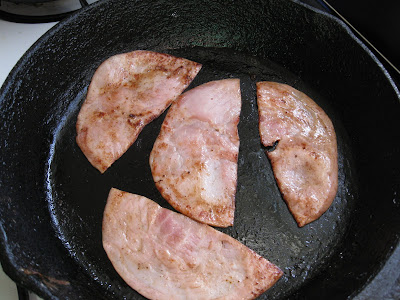This recipe is dinner, my friend Tegan's style. It's a simple cleaning-out-the-fridge stir-fry, or, as she puts it, "throwing shit together in a pan". That, in fact, is a wonderfully succulent summing up of this surpisingly delicious and quick-to-prep dinner.
Ingredients:
Anything you have in the fridge, with one green and one meat. Not comfy with that approach? All right then:
1. A slab of meat, preferably ham (or beef, or chicken, or lamb. We're not particular. You shouldn't be either).
2. Green beans (sheem).

3. Onions--chopped lengthwise.
4. Corn/potato starch.
5. Soya sauce.
6. Mushrooms--if you like them.
7. Eggs--also optional, but I like using them.
8. Broccoli--cut in small florets (optional)
9. Carrots--peeled and diced (optional)
10. Peas in pods--chopped in pods, with the two ends cut off.
11. Shallots--chopped (optional)
12. Celery--chopped (optional).
13. Watercress--cut in halves (optional).
13. Garlic--minced (optional).
14. Pineapple juice (comletely optional. But if you want to substitute, please don't use anything other than lemon juice).
15. Chicken stock (optional)--
not to be used if using pineapple juice.
The number of 'optionals' should give you an idea of the kind of recipe this is :D
How it works:
If using broccoli and/or carrots, steam them till they're nice and soft, but not falling-apart soggy-mess soft. Fifteen to twenty minutes over a medium flame with a cover should do the trick, depending on the strength of the flame. Do
not boil, as some of the flavour and goodness of the veggies go away with the drained water.
Heat oil (Tegan uses olive, I use canola :-] ) in a wok/broad-based pan. When the oil is hot, add garlic (if using), turn flame down to low and fry them till you can smell that yum! frying garlic smell. Now add the onions. You may need to turn up the flame a little, otherwise the onions are likely to lie in the oil, soaking it up but not changing colour.
Once the onions change colour, become transparent and start smelling like frying onions (plus frying garlic) add the ham, diced. If using any other meat--particularly chicken--make sure it had been marinated in lemon juice and salt for at least an hour. Fry well. When the meat begins to acquire brown spots, it's time for the stage 3.

Potato intervention: while the meat browns, dice a few potatoes, put them in a broad pan, fill
with water, add salt, and set to cook over a low flame (see left). This will be done by the time the gravy-stir-fry is done.
Now, in a orderly queue, add each vegetable (except shallots). The ones that take the longest to cook go in first. Forrexumple, carrots and broccoli (which take so long to cook that we had to
steam them first). Toss these about a bit so they don't end up with just one side cooked and the other bland and raw. You may even cover for a couple minutes to make sure the 'hard' vegetables are cooked well. Then add the other vegetables--beans and mushrooms, in our case--and stir fry them on a medium flame so that all the vegetables mix well with the oil. Check to see if the meat has been nicely browned (or in the case of chicken, nicely white-and-gold)--it should be by now. If it is brown crisply fried enough for your tastes, stir in the chopped shallots.
If using eggs, now is the time to add them. Break and whisk all the eggs into a cup. In a separate pan, scramble them well--not the softly scrambled eggs you have for breakfast but
well scrambled eggs. Tip this second pan into the first. Some people like to scramble their eggs in the same big wok/pan before they start the cooking proper, and while this is otherwise fine, scrambled eggs left aside for too long tend to congeal and be generally rather unappetising. Just use a second pan, all right?

To the vegetable-meat-egg mixture, add a small tin of pineapple juice. There's going to be an almighty sizzle. When the sizzle dies down, venture forth and mix the liquid well with the meats abd veg. If using lemon juice, mix with a little water before adding. If using chicken stock, add and stir in. If not using any juice, proceed to next step.


In a bowl of water, add about half a teaspoon of
starch. To this mix some soya sauce (check to see how sweet/salty the soya is). Now add this mixture to the wok/pan. Lower flame, fold in well. Add salt, sugar, ground black pepper. Mix well. Add about two regular teacups of water. Cover. Let it cook over a medium flame till the gravy thickens.
Eat with rice and boiled/salt-potatoes.
And then, exhausted by all the cooking, this is what we did during dinner, plates on our laps. The desserts, alas, are from Dunkin' Donuts. Even we know better than to try make our own donuts. Why waste effort worth 69 cents?






























